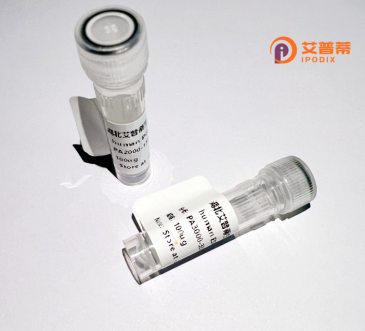
| 纯度 | >90%SDS-PAGE. |
| 种属 | Human |
| 靶点 | TAOK1 |
| Uniprot No | Q7L7X3 |
| 内毒素 | < 0.01EU/μg |
| 表达宿主 | E.coli |
| 表达区间 | 892-1001 aa |
| 活性数据 | LSNLSPEAFSHSYPGASGWSHNPTGGPGPHWGHPMGGPPQAWGHPMQGGPQPWGHPSGPMQGVPRGSSMGVRNSPQALRRTASGGRTEQGMSRSTSVTSQISNGSHMSYT |
| 分子量 | 37.84kDa |
| 蛋白标签 | GST-tag at N-terminal |
| 缓冲液 | PBS, pH7.4, containing 0.01% SKL, 1mM DTT, 5% Trehalose and Proclin300. |
| 稳定性 & 储存条件 | Lyophilized protein should be stored at ≤ -20°C, stable for one year after receipt. Reconstituted protein solution can be stored at 2-8°C for 2-7 days. Aliquots of reconstituted samples are stable at ≤ -20°C for 3 months. |
| 复溶 | Always centrifuge tubes before opening.Do not mix by vortex or pipetting. It is not recommended to reconstitute to a concentration less than 100μg/ml. Dissolve the lyophilized protein in distilled water. Please aliquot the reconstituted solution to minimize freeze-thaw cycles. |
以下是关于重组人TAOK1蛋白的3篇代表性文献及摘要概括:
1. **《TAOK1 Kinase Governs Cytoskeletal Organization via RhoA Activation》**
- 作者:Muir B., et al.
- 摘要:研究揭示了重组表达的TAOK1通过磷酸化RhoGEF蛋白激活RhoA信号通路,调控细胞骨架重塑和迁移,为TAOK1在肿瘤转移中的作用提供了机制支持。
2. **《Structural Basis of TAOK1 Autophosphorylation in Hippo Pathway Regulation》**
- 作者:Zheng Y., et al.
- 摘要:利用重组TAOK1蛋白的晶体结构分析,阐明了其自磷酸化位点及构象变化,揭示TAOK1如何通过Hippo通路调控细胞增殖和凋亡。
3. **《TAOK1 Mediates Neuronal Apoptosis via Interaction with JNK Signaling》**
- 作者:Chen L., et al.
- 摘要:通过体外实验发现重组TAOK1直接激活JNK激酶,介导氧化应激诱导的神经元凋亡,提示TAOK1在中枢神经系统疾病中的潜在治疗价值。
以上文献均聚焦TAOK1重组蛋白的功能研究,涵盖信号转导、结构生物学及疾病模型等领域。
TAOK1 (Thousand And One Amino Acid Kinase 1) is a serine/threonine protein kinase belonging to the STE20 family, which plays a critical role in regulating diverse cellular processes. It is part of the mitogen-activated protein kinase (MAPK) signaling cascade and is implicated in stress response pathways, cell cycle regulation, cytoskeleton reorganization, and apoptosis. TAOK1 contains a conserved kinase domain and regulatory regions that mediate interactions with upstream activators and downstream substrates. Structurally, it includes an N-terminal kinase domain and a C-terminal regulatory region responsible for autophosphorylation and substrate recognition.
Recombinant human TAOK1 protein is engineered for in vitro studies using expression systems like *E. coli* or mammalian cells, ensuring post-translational modifications akin to native protein. This recombinant form enables researchers to investigate TAOK1’s enzymatic activity, substrate specificity, and signaling mechanisms. TAOK1 is known to phosphorylate components of the Hippo pathway (e.g., STK3/STK4) and modulate p38/JNK MAPK signaling, influencing cell proliferation and differentiation. Dysregulation of TAOK1 has been linked to neurological disorders, cancer progression, and immune responses, highlighting its therapeutic potential.
Studying recombinant TAOK1 aids in drug discovery, particularly in developing kinase inhibitors for diseases like Alzheimer’s, autism spectrum disorders, and certain cancers. Its role in neuronal development and synaptic plasticity further underscores its biological significance.
×